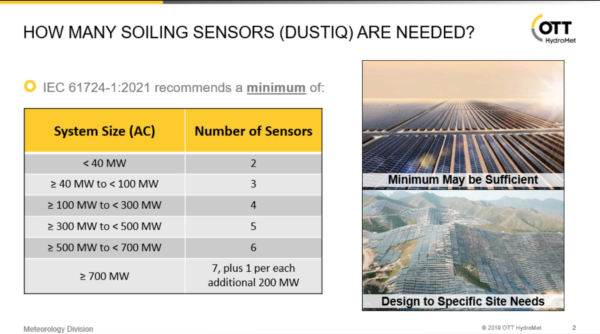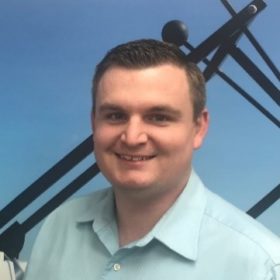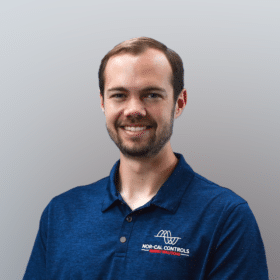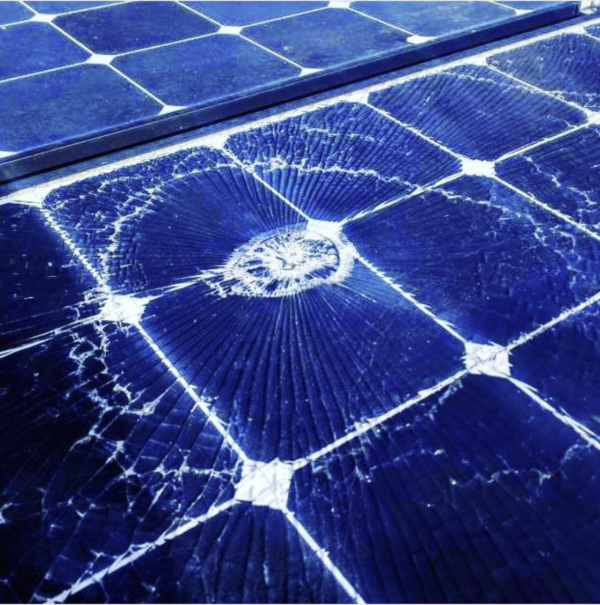In June, pv magazine hosted a webinar taking a deep dive into environmental monitoring, SCADA integration, and solar panel cleaning using robotics and automation to increase awareness of soiling losses and emphasize the importance of long-term considerations during development. Featured speakers included Damon Nitzel of OTT HydroMet, Troy Morlan of Nor-Cal Controls, and Carla Dawson of Relysm.
The goal of a pv magazine webinar is to spark interest and conversation with our audience. Occasionally, it’s just not possible to contain that discussion to a single one-hour webinar timeframe.
Recognizing this, we collected some of the questions that went unanswered in the initial webinar and collaborated with Nitzel, Morlan, and Dawson to conduct an interview, with questions and content entirely sourced by you and your fellow attendees.

If you didn’t attend the webinar when it aired live, fret not. The full replay and presentations are available by following this link. Any entries italicized below denote questions that pertain to a slide or graphic within the presentation.
Q&A extended
Q: What irradiance values are considered for the calculation of the Soiling Ratio? Greater than 50 or 100 Watts per square meter?
A: The DustIQ uses an internal LED to generate the measured signal and collect soiling data, which is not influenced by irradiance, so irradiance values were not considered as part of this presentation. This also means the DustIQ provides data day and night as long as the surface of the sensor is dry. The soiling data presented were daily measurement at 1400, so it’s presumed the irradiance was greater than 100 W m-2 for all measurement times, and also that the sensor is dry at this time of day with few exceptions.
Q: Does DustIQ measure uneven soiling in utility scale sites?
A: DustIQ assumes there is uniform soiling. Installing multiple DustIQ gives a plant profile which can account for uneven soiling.
Q: What is the optimal number of soiling stations per area to ensure accuracy?
A: IEC 61724-1:2021 Class A sites require a minimum number of soiling sensors per MW (see table below). We recommend using this as a starting guideline to determine the quantity of sensors needed in order for the soiling measurements to be representative of the soiling across the arrays. Inter- and Intra-site variability (farm activity, maintenance roads, atmospheric dust, car exhaust, and so on), as well as cleaning zones are all factors to consider where additional soiling measurements might be needed to represent a unique area of soiling within a large site or amongst a portfolio of smaller sites.

Q: Question regarding the number. I think I’m confused because it seems that the cost to clean about $1.2M over 10 years. And the savings over 30 years is about $3.6M. This would appear to be a net wash of $0. Is this accurate?
A: The cleaning cost was included in the total savings calculation. Revenue loss is expected revenue, minus actual revenue. Actual revenue is energy sold, minus cleaning costs. When no action is taken, there are no cleaning costs, but also less production. When cleaning costs are higher than recovered production, this results in a net less (manual cleaning example). When cleaning costs are optimized, cleaning costs are less than recovered production and this results “savings” relative to taking no action (semi-automated examples).
Q: How is manual cleaning giving higher percentage in revenue loss than no cleaning?

A: In this case study, manual cleaning resulted in a higher revenue loss because the cost of manual cleaning was higher than the cost to wait for rain to do the cleaning. This does assume that the major rain event (the 2nd event after the manual cleaning, seen in the blue line in the presentation) does completely clean the panels from a more heavily soiled state than they were in the actual data, so there may be a small (1-2%) error introduced by this assumption.
Regions with lower labor rates may not pencil out the same, and manual cleaning will save revenue. In some cases, manual cleaning rates will be more effective than semi-automated tractor rates, such as in Pakistan where manual cleaning was reported as $200/MW.
Q: How often should we collect soiling data? Is daily sufficient, or as high as per minute?
A: One measurement per minute, with the intent to have one correct daily value. There are situations, like sand storms, where real-time data may give earlier warning of maintenance needs, but most sites per day will rarely use intra-day data. An exception would be higher soiling rate locations that are using fully automated solutions.
Q: How long does it take to clean? Are you considering that the cleaning is performed in one day?
A: For this case study, only for simplicity, we did assume that the entire 100 MW site was cleaned in a single day. In reality, 1-2 weeks would be a more realistic cleaning time frame. However, given consistent soiling rates present in this data, we do not believe there would be significant differences in the outcomes if we accounted for 1/12th cleaning per day.
Q: Do you consider in your model potentially non-linear losses associated to inhomogeneous soiling (mismatch, hot spots, and so on)?
A: For this case study, we assumed that the soiling measurements were 100% representative of the soiling on the panels. A single sensor at a 100 MW site is unlikely to match this assumption, but increasing the soiling data density with multiple sensors will bring the soiling data closer to 100% representation of actual soiling on the panels.

We expect intra-site variability and suggest installing soiling monitoring equipment in zones that are representative of unique circumstances. It’s quite possible partial site cleaning for more heavily soiled zones will be the most effective approach, or recover the most soiling loss, compared to cleaning a whole site averaged and treated as a whole.
Q: For automatic robot cleaning, what is the cleaning cycle considered? One cycle per day or less frequent?
A: Typically, automated solutions are expected to clean at least once per day. But, why limit yourself to a set schedule? Pairing automation and soiling data will save power and lifetime of the automation equipment and solar panel surface by only cleaning when it is necessary to optimize production, whether that is multiple times a day or skipping days.
Q: In a scenario where robotic-non-water cleaning is the intended long-term solution, is there no negative impact on soiling expected?
A: Cleaning with water has to be done at some point in time. Dry cleaning is great for day to day soiling issue but eventually you have to clean with water because dry cleaning does not avoid cementation. Even in the driest parts of the world, there is dew and dew leads to cementation.
Q: Is the same equipment used to clean bifacial panels as mono-facial?
A: There are several ways to go about doing this:
- Custom robots – made to order
- One tractor with one brush
- A tractor with two hydraulic arms and two brushes. The brush can be used on both sides. However, the ideal solution which is “custom” is a tractor with two hydraulic arms and two brushes. As it drives down the row it cleans twice as many panels.
Q: Is water used in the cleaning “recycled” through the cleaning process, or does the used water flow to the ground?
A: Water is not recycled in the current cleaning methodologies. It is wasted and there is room for improvement.

Q: Do the robotic and tractor cleaning studies take corrective and preventive maintenance estimates of those pieces of equipment in to consideration?
A: Yes. The values shown in the webinar take into consideration solar panel cleaning robot operational expenditure values and more. The financial studies took into consideration O&M for the machinery and other factors.
Q: Cleaning brush scouring is probably minimal, but soiling can be very abrasive. What is the transmission degradation rate due to scouring by abrasive soiling (creating reflective scratches in the panel glass)?
A: This is a very good thing to look into. Before you buy any cleaning machinery, you should know the abrasion levels or, better yet, check if the machinery is certified by the PV panel manufacturer. For the systems shown, we do not have the abrasion levels because we have the PV panel manufacturers’ certification.
Q: Is it possible to use air for cleaning?
A: Air cleaning is being used and it has partial efficacy. It only works in very arid areas and some kind of brush or fabric is used with air to accomplish cleaning the PV panels. Air cleaning alone does not do the job.
Q: Does the rate of soiling have any relation to module degradation over the lifetime of the site? Is weather forecasting taken into consideration for determining module soiling loss over the lifetime of the site?
A: To my knowledge, there is no news of soiling-related degradation, but there could be, as soiled areas usually get hotter. It can make sense to take weather forecasting into account to determine soiling loss over the lifetime. Rain is considered a cleaning mechanism for soiling.
Q: Has any data been published comparing DustIQ soiling measurements vs a two panel setup (clean module / dirty module) vs IV curve measurements in the field?
A: As far as I know there was work done in Spain and Morocco and an approach in Saudi Arabia. A publication about Morocco is in preparation, but it has been underway for a while and progress has been slow. The Morocco publication focuses more on the incidence angle effect and not on real soiling values.
This content is protected by copyright and may not be reused. If you want to cooperate with us and would like to reuse some of our content, please contact: editors@pv-magazine.com.









This is some great stuff Tim and thank you for sharing the Q&A. It’s amazing the difference in revenue just by doing simple case studies. Taking an example from your article, this is an interesting study.. ” In this case study, manual cleaning resulted in a higher revenue loss because the cost of manual cleaning was higher than the cost to wait for rain to do the cleaning.”
It’s great to see that data was used to see if it’s worthwhile or not. Love to gain knowledge and data off of these Q&A and always appreciate the answers from these amazing experts.